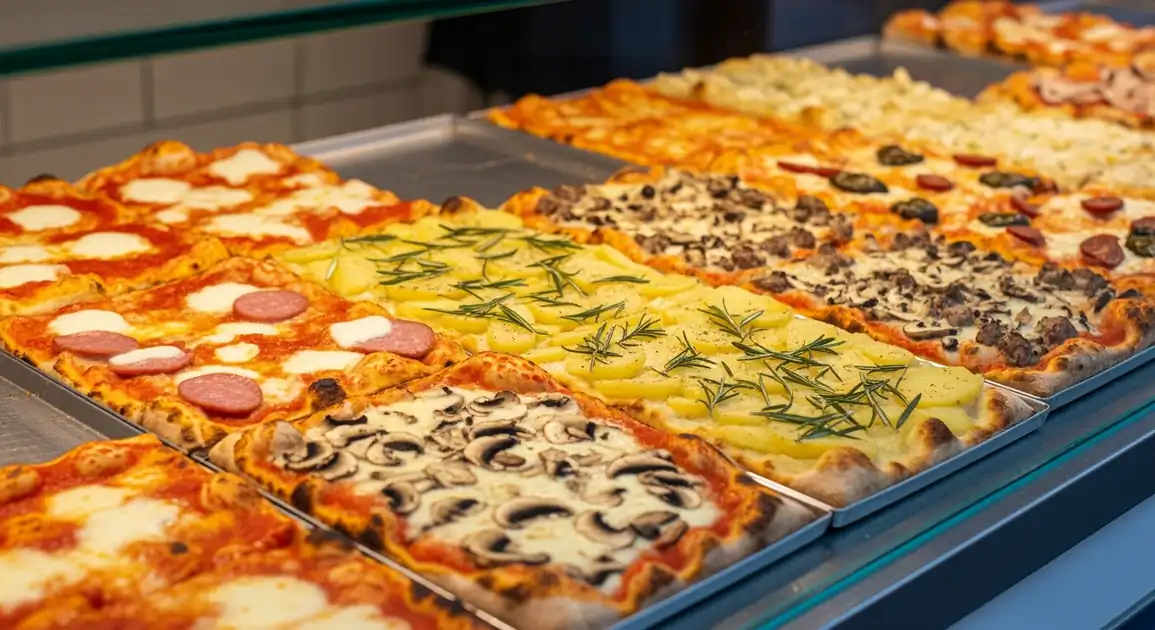Pizza al Taglio (Pizza by the Slice)
Pizza al Taglio

Description
Rome is the undisputed capital of Pizza al Taglio. Here, it's an art form, found in countless dedicated shops ('pizzerie al taglio') and historic bakeries ('forni'). Roman pizza al taglio is celebrated for its light, airy, digestible crust achieved through long fermentation, and classic toppings like potato & rosemary, fiori di zucca (seasonal), and simple pizza bianca/rossa are perfected.
Dietary Information
Serving information
Serving style
Quintessential Roman street food. Eaten standing, walking, or at minimal counter space. Often accompanied by 'supplì' (fried rice balls) if available at the shop.
Quick facts
Bakeries open early (8 AM - 9 AM), Pizzerie al Taglio often 10 AM - 8 PM or later, some close mid-afternoon.
Safety Tips
What to Look For
-
High customer turnover.
Busy shops sell pizza quickly, ensuring it's fresh and hasn't been sitting at room temperature for extended periods.
-
Fresh-looking, vibrant toppings.
Toppings should look recently prepared, not dried out, wilted, or discolored. Cheese should look properly melted, not congealed or oily.
-
Crispy, golden-brown crust base.
Indicates proper baking and freshness. A soggy base can suggest it's old or wasn't baked correctly.
-
Clean counter, cutting tools, and serving area.
Basic hygiene is essential. Look for clean surfaces, tongs/spatulas, and vendor hygiene.
-
Option to reheat the slice ('Lo scalda?').
Reheating briefly in a hot oven not only improves taste and texture but also helps ensure it's served hot, reducing potential bacterial growth.
What to avoid
-
Pizza that looks like it's been sitting out for hours.
Increased risk of bacterial growth and degraded quality (dry toppings, soggy crust).
-
Dried out, sparse, or dull-looking toppings.
Indicates lack of freshness and poor quality.
-
Soggy or pale crust underneath.
Suggests poor baking, old pizza, or absorption of moisture over time.
-
Visible flies, pests, or general uncleanliness around the food display.
Clear sign of poor hygiene standards.
-
Vendors handling money and food without washing hands or changing gloves.
Risk of cross-contamination.
Price information
Price range
Budget tips
- Campo de' Fiori area bakeries offer classic, affordable slices.
- Testaccio market has some great options.
- Prices can be higher at famous 'gourmet' spots like Pizzarium, but quality is exceptional.
- A slice of Margherita or Rossa is generally cheaper than slices with prosciutto or complex toppings.
Value indicators
- Famous name/reputation (e.g., Bonci/Pizzarium, Roscioli, Forno Campo de' Fiori).
- Long queues of locals (especially during lunchtime).
- Visible quality of dough (airy 'alveoli').
- Use of high-quality, seasonal ingredients.
Where to Find This Dish
Campo de' Fiori / Centro Storico
Historic bakeries like Forno Campo de' Fiori and Roscioli offer iconic Roman slices.
Campo de' Fiori market, Piazza Navona vicinity
Morning, Lunchtime
Trastevere
Plenty of traditional and modern pizza al taglio places catering to locals and tourists.
Piazza di Santa Maria in Trastevere, Side streets
Lunchtime, Evening
Prati (near Vatican)
Home to the famous Pizzarium by Gabriele Bonci, known for gourmet toppings and high-quality dough.
Vatican Museums, Cipro Metro Station
Lunchtime, Early Evening
Testaccio
Known for its food market and traditional eateries offering authentic Roman fare, including great pizza al taglio.
Testaccio Market
Lunchtime
Vendor Tips
- Be prepared for queues at famous spots, especially during peak hours.
- At gourmet places like Pizzarium, be adventurous and try unusual topping combinations.
- Learn the names of key toppings (patate, margherita, bianca, rossa, funghi, salsiccia).
- If paying at a separate 'cassa', get your receipt ('scontrino') before going to the counter to collect your pizza.
How to Order
Regional Variations
-
Pizza Bianca Romana
(Pizza Bianca Romana)
The Roman version is often slightly thicker than elsewhere, perfect for splitting and filling like a sandwich (e.g., with mortadella).
-
Fiori di Zucca e Alici
(Fiori di Zucca e Alici)
A classic Roman topping combining delicate zucchini flowers with salty anchovies and mozzarella – a must-try in season.
-
Patate e Rosmarino
(Patate e Rosmarino)
While found elsewhere, the Roman version with thinly sliced potatoes, rosemary, and olive oil is iconic.
-
Suppli al Telefono
(Suppli al Telefono)
Often sold alongside pizza al taglio, these fried rice balls filled with tomato ragu and mozzarella are another Roman street food essential.
Cultural context
History
While hearth-baked flatbreads are ancient, Pizza al Taglio in its modern form gained prominence in Rome, likely in the post-WWII era. Bakeries ('forni') began utilizing their large ovens and dough expertise to create these rectangular pizzas as an affordable, satisfying food for workers. Its convenience and variety fueled its popularity, making it ubiquitous across Rome and spreading throughout Italy.
Local significance
More than just food, Pizza al Taglio is a daily ritual and integral part of Roman life. It embodies the city's love for simple, high-quality ingredients and casual dining.
Eating customs
- No fuss, no frills. Grab a slice and enjoy.
- Often folded for easier handling.
- Perfect accompaniment to exploring the city on foot.